U.S. Department of Transportation
Federal Highway Administration
1200 New Jersey Avenue, SE
Washington, DC 20590
202-366-4000
http://www.ence.umd.edu/mdt2center/training/on_request.htm
https://www.dot7.state.pa.us/LTAP/
http://personalweb.smcvt.edu/vermontlocalroads/New/circuit_rider/circuit_rider.htm
Table A.1. Contact Information for Existing SCR Programs
|
State |
SCR(s) or Point of Contact |
Phone |
|
|
Arizona |
Mike Blankenship (SCR) |
602-712-7601 |
mblankenship@azdot.gov |
|
Connecticut |
Donna Shea |
860-486-5400 |
shea@engr.uconn.edu |
|
Delaware |
Matheu Carter (SCR) |
302-831-7236 |
matheu@udel.edu |
|
Florida |
Gordon Burleson (SCR) |
352-213-8315 |
burleygator@bellsouth.net |
|
Florida |
Larry Hagen (SCR) |
229-237-3269 |
larry@LarryHagen.com |
|
Florida |
Ed Kant (SCR) |
239-598-3123 |
ejkpe@comcast.net |
|
Florida |
Nina Barker |
352-392-2371 |
nina@ce.ufl.edu |
|
Idaho |
Bruce Drewes |
bdrewes@uidaho.edu |
|
|
Indiana |
Richard Domonkos |
765-494-4225 |
rdomonko@purdue.edu |
|
Iowa |
Tom McDonald (SCR) |
515-294-6384 |
tmcdonal@iastate.edu |
|
Kentucky |
Lance Meredith (SCR) |
859-257-7405 |
meredith@engr.uky.edu |
|
New Jersey |
Janet Leli |
732-445-5236 |
jleli@rci.rutgers.edu |
|
New York |
David Orr (SCR) |
607-255-8033 |
dpo3@cornell.edu |
|
Northern Plains |
Dennis Trusty |
701-255-3285 |
dtrusty@uttc.edu |
|
Northern Plains |
Theodore Danks (SCR) |
701-255-3285 |
tdanks@uttc.edu |
|
Ohio |
Mike Fitch (SCR) |
614-387-7358 |
Mike.Fitch@dot.state.oh.us |
|
Ohio |
Dave Weir (SCR) |
614-387-7358 |
|
|
Pennsylvania |
Mark Hood (SCR) |
814-238-1170 |
mhood@pennoni.com |
|
South Dakota |
Ken Skorseth (SCR) |
605-688-4185 |
ken.skorseth@sdstate.edu |
|
Tennessee |
John Tidwell (SCR) |
615-855-1755 |
jorjtidwell@bellsouth.net |
|
Utah |
Doyt Bolling |
435-797-2931 |
doyt@cc.usu.edu |
|
Vermont |
Steve Jerome (SCR) |
800-462-6555 |
sughouse@sover.net |
|
West Virginia |
Ron Eck (SCR) |
304-293-3031 |
ronald.eck@mail.wvu.edu |
|
Wisconsin |
Steve Pudloski |
608-262-8707 |
pudloski@epd.engr.wisc.edu |
|
Wisconsin |
Pete Rusch (SCR) |
608-262-8707 |
peterlic@charter.net |
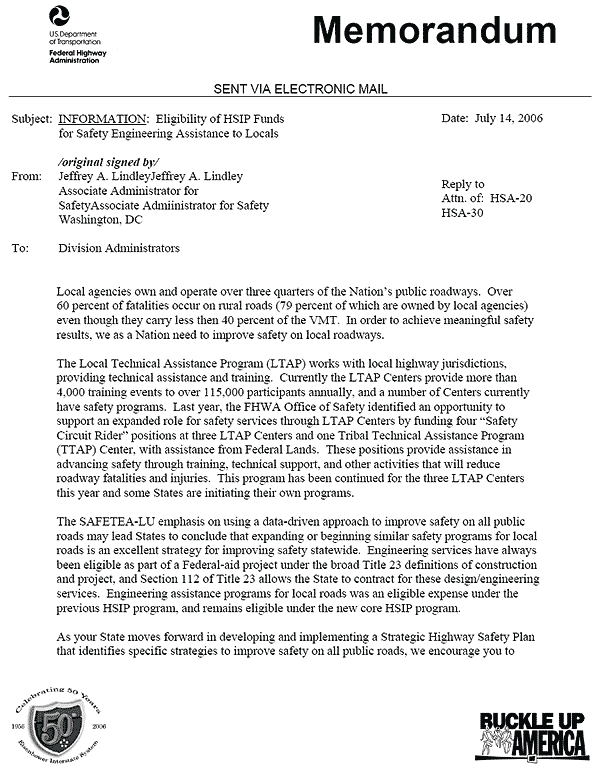
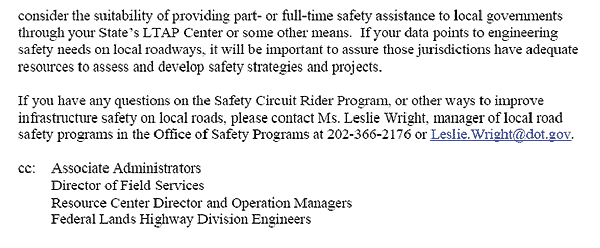
The following is a copy of the cover page of California’s grant proposal. The bulk of the proposal was dedicated to the grant description, which is described in further detail on the next page followed by a copy of the proposed budget for the program.
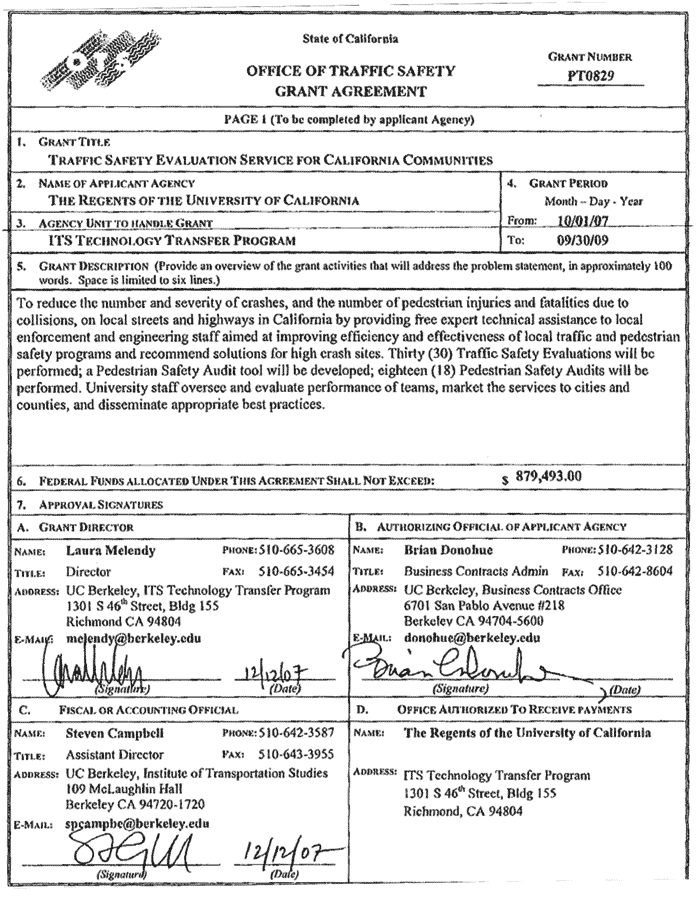
Problem Statement: This section includes a background of safety statistics in the State, emphasizing the number of pedestrian- and bicycle-related fatalities as well as the State goals for reducing these fatalities. The problem statement also outlines the role of local agencies in reducing pedestrian- and bicycle-related fatalities and makes a case for additional support at the local level.
Grant Goals: The section listed two specific goals of the program, indicating the target audience (i.e., local engineering and enforcement agencies) and specific dates of completion. The following is an example of one of the two goals:
To enhance traffic safety in California cities and counties that receive Traffic Safety Evaluations by working with local engineering and enforcement agencies and recommending practical ways to improve the efficiency and effectiveness of local traffic safety programs by September 30, 2009.
Grant Objectives: Several objectives were listed under each anticipated activity. Activities included traffic safety evaluations (TSE), pedestrian safety audits (PSA), and media outreach. Three of the nine TSE objectives are listed below as an example.
To conduct 30 2-day site visits on request from cities or counties in California focused on benchmarking local traffic safety programs against similar communities in California and recommending solutions for locally identified problems by September 30, 2009.
To assist local police and traffic engineering staff in their efforts to design coordinated traffic safety programs and locate resources to fund their implementation by September 30, 2009. To produce a report of findings for each site visit that documents recommendations by September 30, 2009.
Method of Procedure: This section outlined the tasks to be completed during each phase of the program as well as the anticipated start and completion dates for each phase. There were a total three phases:
Method of Evaluation: This section described how the grant manager would evaluate the program based on the data compiled in Phase 3. Specifically, the grant manager will evaluate: (1) how well the stated grant goal and objectives were accomplished, (2) if all the activities outlined in the “Method of Procedure” were performed in accordance with the grant agreement, and (3) the cost-effectiveness of the grant.
Administrative Support: This section outlined the administrative support available through the University Of California Berkley Institute Of Transportation Studies and its Technology Transfer Program.
Proposed Budget:
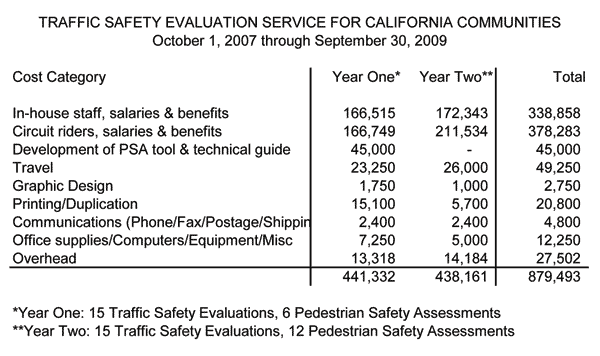
Scope
In an effort to improve intersection safety and to minimize consequences of run-off-the-road crashes, the UW-Madison based Transportation Information Center (LTAP) and the Traffic
Operations and Safety (TOPS) Laboratory are proposing an outreach strategy to assist local agency partners.
In Wisconsin, 66 percent of intersection crashes occur on local roads and 90 percent of the fatalities from run off the road crashes occur on rural roads. Evidence from other LTAP Centers indicates that reductions in crashes at intersections and rural roads can be achieved with a coordinated outreach approach to local agencies that includes safety engineering analysis and on-site technical assistance provided by safety circuit riders. This proposal envisions two part-time traffic engineering professionals who would perform the tasks listed below.
Additionally, the TOPS Laboratory is engaged in numerous safety engineering projects with WisDOT that could serve as a basis for providing local road safety information, such as:
The project includes two components: back office traffic safety engineering analysis and outreach oriented safety circuit riders. In coordination with LTAP, the TOPS Laboratory will process requests for local crash data and provide summary data and a customized catalog of appropriate countermeasures to the circuit riders who will work with local governments.
The Safety circuit riders will:
Benefit
Using the single automated statewide crash mapping application, TOPS can perform traffic
safety analyses to identify critical locations and crash causes for the purpose of decision
support. Using the safety analysis produced by TOPS, safety circuit riders can provide hands-on technical assistance to local officials thereby implementing safety measures to mitigate safety problems and ultimately save lives and the loss of property.
Cost
Total funding for the two year pilot is anticipated to total $280,000. Approximately $50k
per year is designated to support the local roads-oriented analysis at the TOPS Laboratory
and $90k per year would be allocated to support two, part-time safety circuit riders.
Source of 10% match funds
The Wisconsin Transportation Information Center (LTAP) source of the 10% matching comes from publications sales and course registration fees.
Support relevance to SHSP emphasis area
Activities would specifically support SHSP Issue Area 2: Improve Design/Operation of
Intersections and Issue Areas 6&9: Keep Vehicles on the Road and Minimize Consequences
of Leaving the Roadway.
The following is a copy of the Wisconsin contract budget. It should be noted that this budget was amended to reduce the academic salaries and fringe benefits in an effort to increase the SCR salary and travel budget by $23,000.
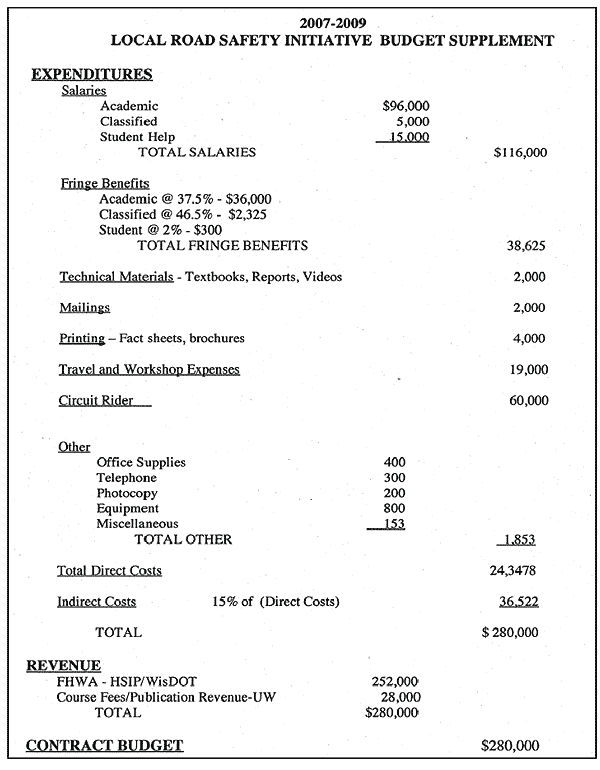
This appendix provides commentaries from existing safety circuit riders about the important characteristics and qualifications for safety circuit riders.
Florida
Florida currently employs three safety circuit riders, 1) a former public works director, 2) a retired DOT engineer, and 3) one with a diverse background. The following commentaries are from current Florida safety circuit riders related to the desired characteristics of a SCR.
SCR #1 (Ed Kant):
To be proficient, a safety circuit rider should have a good relationship with local agencies, background in traffic engineering, good knowledge of how government works (e.g., budgeting, public law, and local ordinance requirements in terms of what it takes to get projects funded and completed), and be comfortable speaking to groups.
A SCR also needs to understand how to bypass the typical engineering process to implement low-cost countermeasures. Many of the situations encountered by a SCR can be enhanced through simple measures such as improving signs and pavement markings or trimming trees to improve sight distance. These types of improvements do not require a complete engineering study.
SCR #2 (Gordon Burleson):
Safety circuit riders should have some public speaking skills and a professional background specifically related to the area in which the clients work. The SCR must be able to communicate to field maintenance personnel, engineers, and politicians. If the SCR’s background is closely related to the field personnel and engineers, their suggestions are more likely to be accepted. If the SCR is a professional engineer, their suggestions are more likely to be accepted by politicians (county commissions).
In regard to having a background in traffic engineering, it is best if the SCR has field implementation and/or maintenance experience rather than design experience. It also helps if the SCR has over 15 years of experience; being under the age of 35 may not be desirable due to issues with credibility and experience.
SCR #3 (Larry Hagen):
A safety circuit rider must be a person with a passion for reducing crashes and the resulting injuries and fatalities, a strong traffic safety CHAMPION. The safety circuit rider must have the ability to communicate with people at all levels within the hierarchy of a transportation agency from the maintenance worker to the engineer, as well as with other people including law enforcement officers, elected officials, the press, and the public. The SCR must have a few gray hairs gained from the school of hard knocks, and ideally would have a broad and diverse background that may include design, operations, and/or maintenance responsibilities.
Above all, the most important thing that a SCR must bring to the table is a spirit of cooperation. To be effective in making the changes that are necessary to bring about any improvement, the SCR often has to bridge jurisdictional issues that exist between agencies. It could be responsibility issues between state and city/county agencies, or long-standing discord between traffic engineering and law enforcement. The SCR’s focus must be on getting the right players to the table to bring about effective change. All of the players have a part in making our roadways safer, but no one player has the whole; all of the E’s (engineering, education, enforcement, EMS, encouragement, everyone else, etc.) must work together to make substantive safety improvements.
Iowa
According to the Iowa SCR, the most essential characteristics for a safety circuit rider are
credibility, the ability to communicate well, and a passion for roadway safety. Retired county
engineers have an established relationship with local agencies and also command a certain level of respect and credibility from local agencies because they are seen as “one of their own.” County engineers, however, often do not have a strong safety background and it is often
necessary to provide them with this skill set through train-the-trainer or similar programs.
A background in traffic engineering and/or safety would be valuable for safety circuit riders,
but is not mandatory because a person with a passion for safety can obtain this knowledge through professional development or training.
The Iowa SCR has never been a county engineer, but has worked with local agencies extensively throughout his career with the Iowa DOT. This has helped build a degree of credibility among local agencies. Also, the SCR has been involved in a considerable amount of research throughout his career. While the research activities are mostly an interest of the Iowa SCR, and not necessarily a requirement of the SCR position, the results of many of these studies have provided excellent opportunities to share safety information with local agencies and develop resources such as handbooks and manuals.
Pennsylvania
The following commentary is from a current SCR in Pennsylvania related to the desired
characteristics of a SCR.
Mark Hood:
It is important for a SCR to have a technical knowledge in traffic engineering, operations, and traffic safety with an understanding of design, maintenance, and liability issues. It is best if the SCR has field implementation and/or maintenance experience rather than design experience. More importantly, they should know if something will work in the field and how to get it implemented in the field. It is also helpful for a SCR to have a good understanding of State law, operation of local government, and existing resources and manuals. It is important for a SCR to be a registered professional engineer, but the age of the SCR is secondary to experience. To be effective, the SCR should be able to explain engineering concepts in a useful manner to a non-engineering audience (i.e., they must be able to relate to all audiences: law enforcement, elected officials, designers, and road laborers). Finally, the SCR must be willing to travel as part of the job and be comfortable and effective at public speaking.
West Virginia
The West Virginia SCR program identifies circuit riders based on the required characteristics.
According to the SCR, desired characteristics include adequate knowledge of design and
operations (e.g., guides, policies, and issues), diverse knowledge in safety, willingness to travel, ability to communicate and work with others, public speaking skills, and ability to work in the field and provide hands-on assistance.
The three safety circuit riders in Florida are focusing on 10 of the 67 counties (see Program Initiation for additional details). Table E.1 provides an example of the number of training activities that occur during a typical year. These training activities include those conducted from January through September of 2007.
Table E.1. Overview of 2007 Training Activities in Florida (January to September)
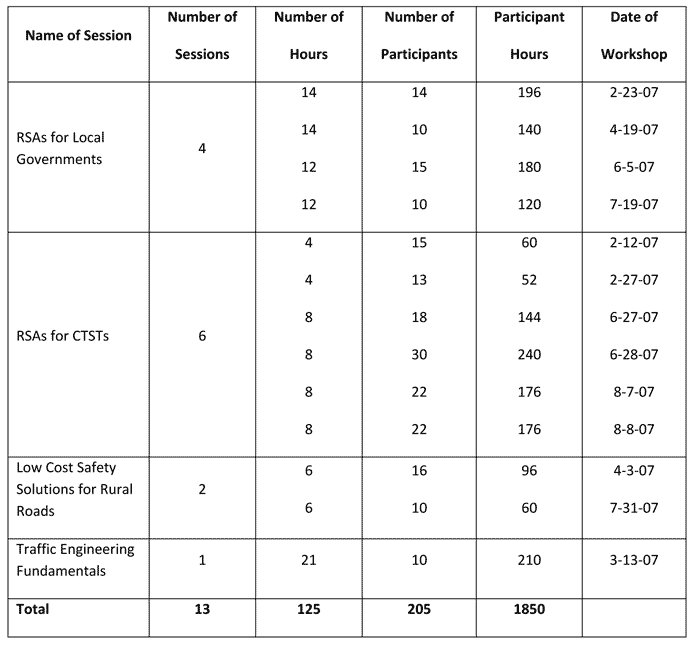
Table E.2 provides an example of the number of training activities that occur during a typical year in Pennsylvania. These training activities include those conducted from 2006 through 2008.
Table E.2. Overview of 2006-2008 Training Activities in Pennsylvania
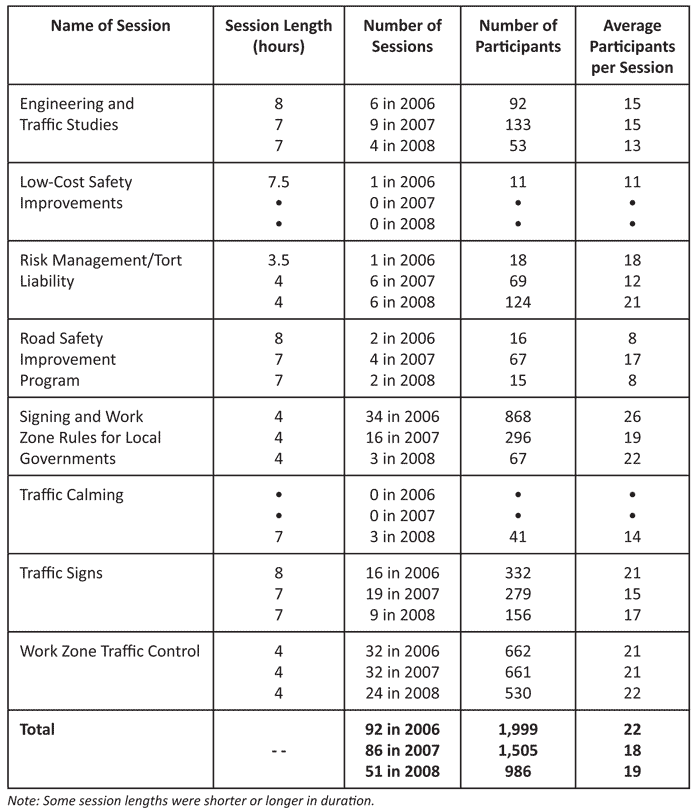
Table E.3 provides an overview of presentations made by the West Virginia LTAP in 2007, all of which were provided by the SCR as formal workshops. Training opportunities also include presentations (1 to 2 hours) at state and regional safety venues, community group meetings, and to elected bodies.
Table E.3. Overview of 2007 Training Activities in West Virginia
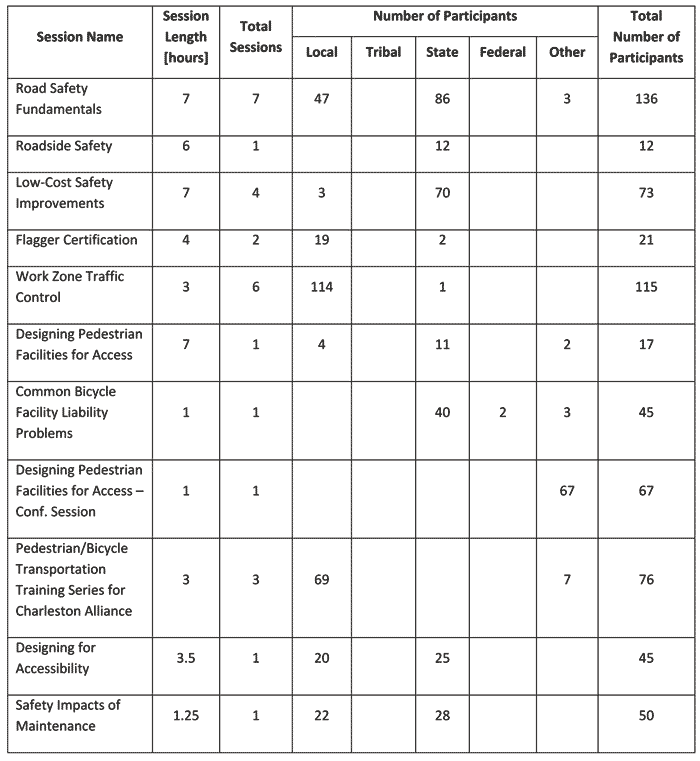
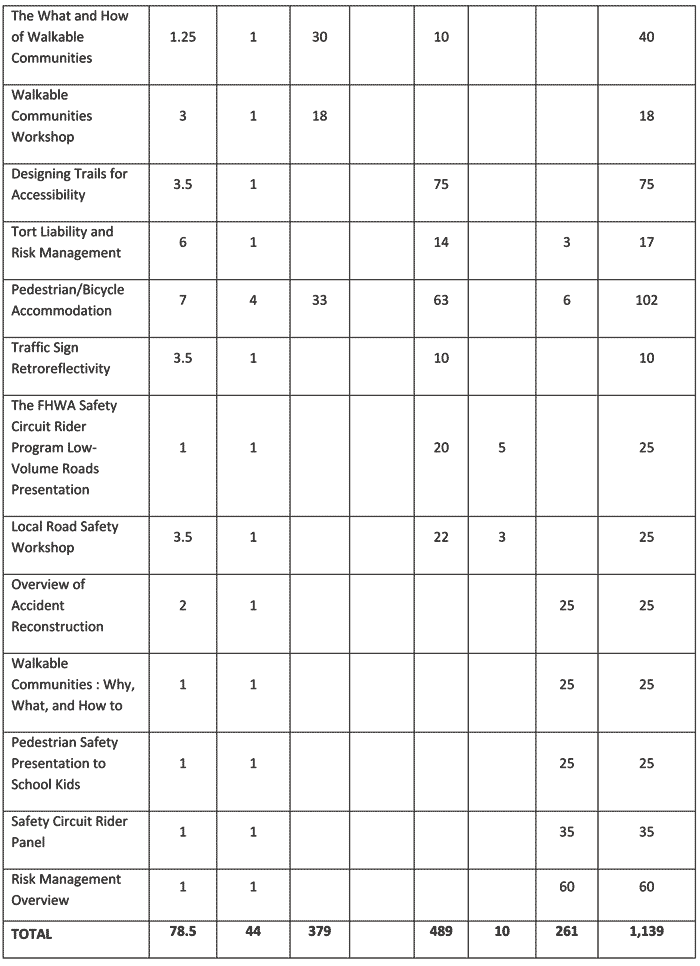
Pasco County RSAs
Larry Hagen, a SCR for the central region of Florida, has conducted multiple RSAs in Pasco
County. Pasco County was one of the first counties in Florida to utilize the SCR for conducting RSAs on a large-scale. To determine the locations of greatest need regarding safety, a
preliminary list of intersections was developed utilizing the Pasco County Crash Data
Management System (CDMS). Criteria to identify the high-priority locations included: average number of crashes per year, total number of fatalities, total number of injuries, percentage
of angle crashes, percentage of left turn crashes, and percentage of crashes occurring at
intersections. The list of candidate intersections was then reviewed by Pasco County Traffic
Engineering staff and modified to reflect the County’s work program schedule (i.e., locations already scheduled for improvements were eliminated from the list). This process identified the top 10 intersections for a RSA.
The RSA team was assembled by the FHWA with assistance from the Florida DOT Traffic Operations staff. The team included members from the FHWA, Florida DOT Traffic Operations, Pasco County Traffic Operations, Pasco County Sheriff Office, City of New Port Richey, a consultant, Florida SCR (Larry Hagen), and URS Corporation.
The SCR led the RSA using the traditional eight-step RSA process for all 10 intersections. The SCR produced a comprehensive RSA report describing the suggested measures ranging from
short-term solutions such as signing and pavement marking modifications to geometric changes such as adding turn-lanes (see Table E.4 below). The SCR also added a step to the RSA process. This was a RSA follow-up one year after the initial RSAs involving the same RSA team members. This enabled the team to not only ensure actions were taken to address potential safety issues, but permitted the review of suggested intermediate and long-term measures.
Table E.4. Example of Issues Identified and Suggestions from Pasco County RSA

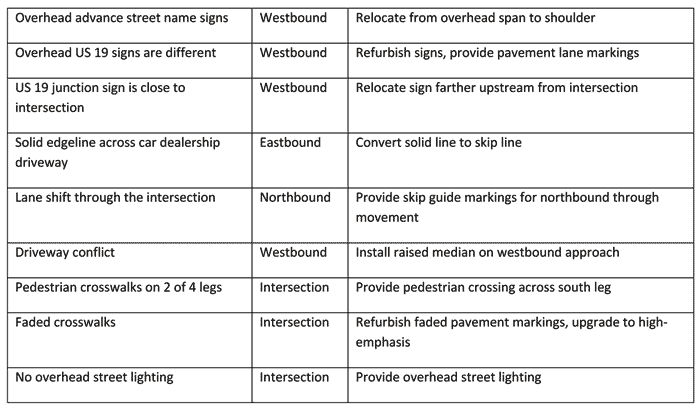
Local Safe Roads Communities
Walkable Communities
Road Safety Audit Reviews
Tech Assist
Advanced Tech Assist
Tech Assist for a Day (Visiting Engineer Program)
Sample Technical Information Sheet: The following is an example of a technical information sheet. The SCR publishes technical information sheets through the Pennsylvania LTAP Center to provide detailed information on a specific topic. The sample technical information sheet focuses on new signing and work zone rules for local governments.
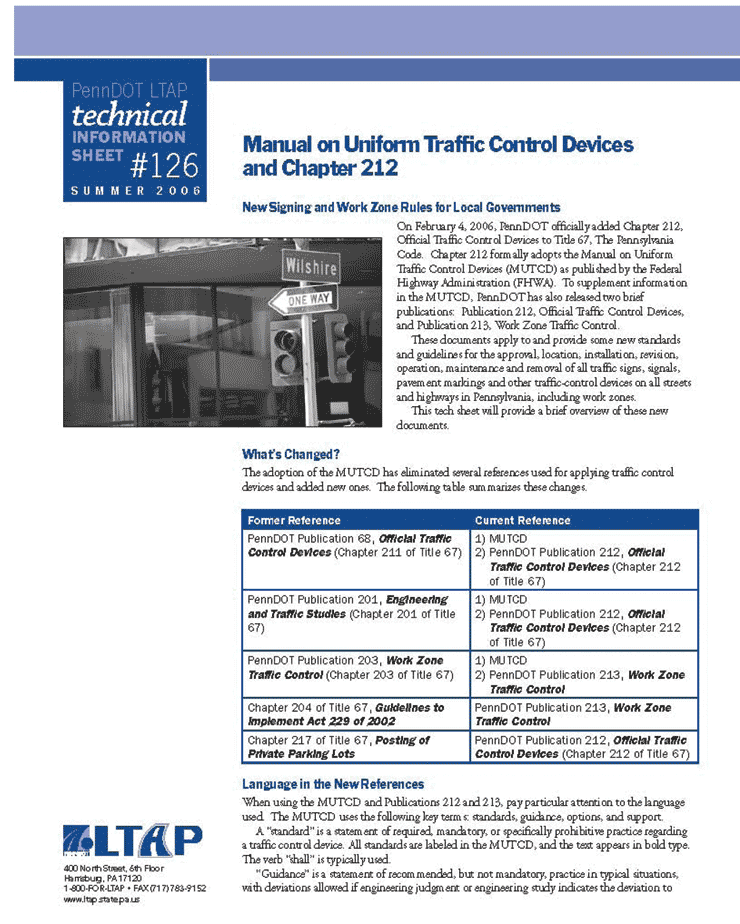
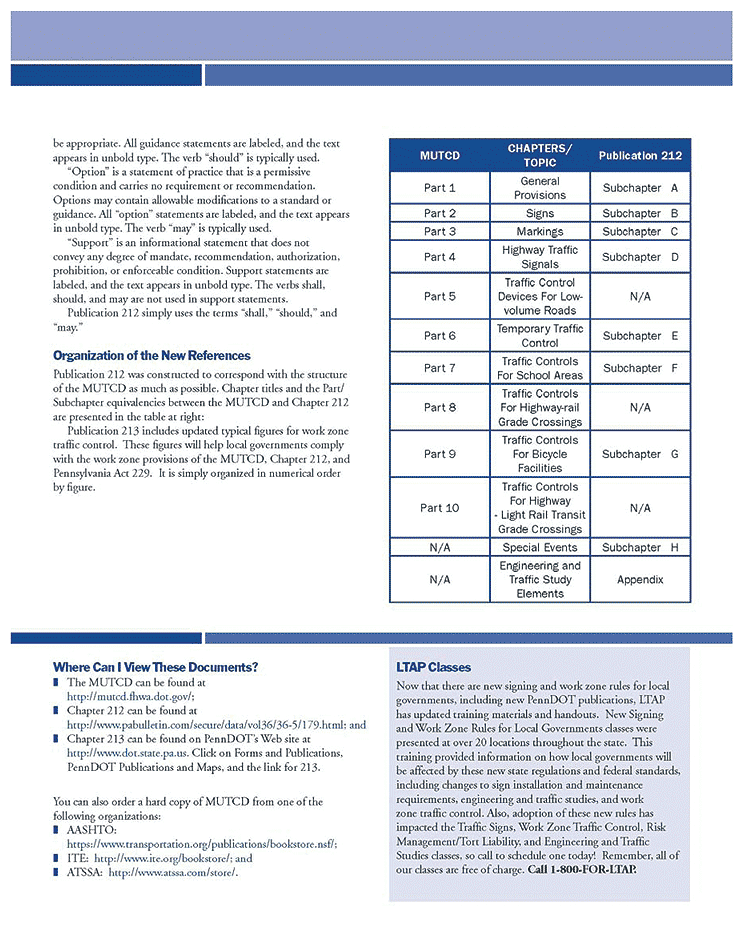
On September 7, 2005, West Virginia LTAP (Local Technical Assistance Program) engineers Ron Eck, Mike Blankenship, and Brad DiCola met with Easton Elementary School officials and parents to discuss the traffic circulation of buses and teacher/parent vehicles entering and exiting the school property. School representatives included Principal Hlad, student parents Sherry Williams and Donna Weems, and bus driver Joe Boyles. Based on our discussions, an on-site review, and a bus turning radius demonstration, we developed the following recommendations with student safety in mind.
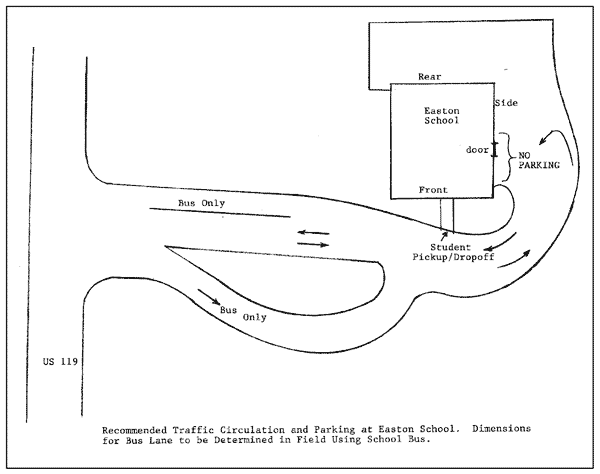
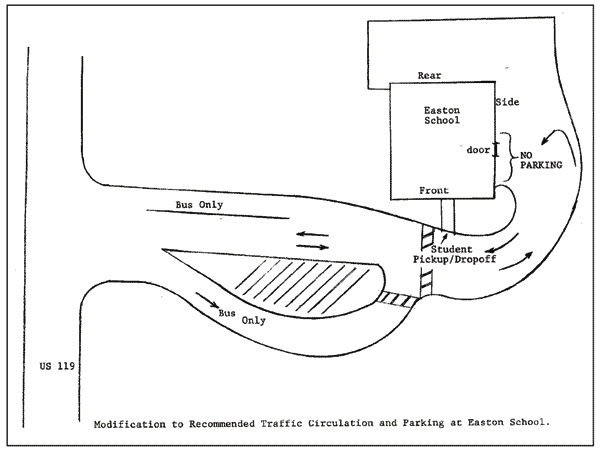
Walkabout of Port Marion, Pennsylvania
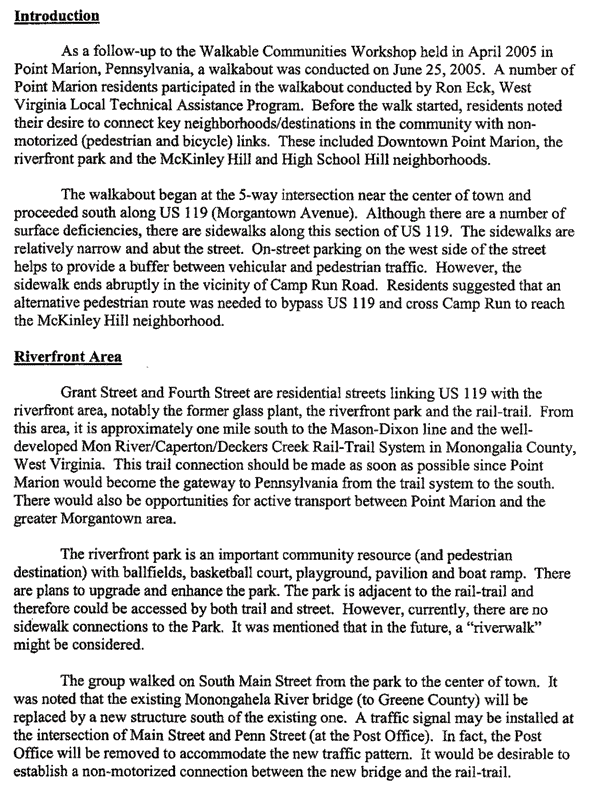
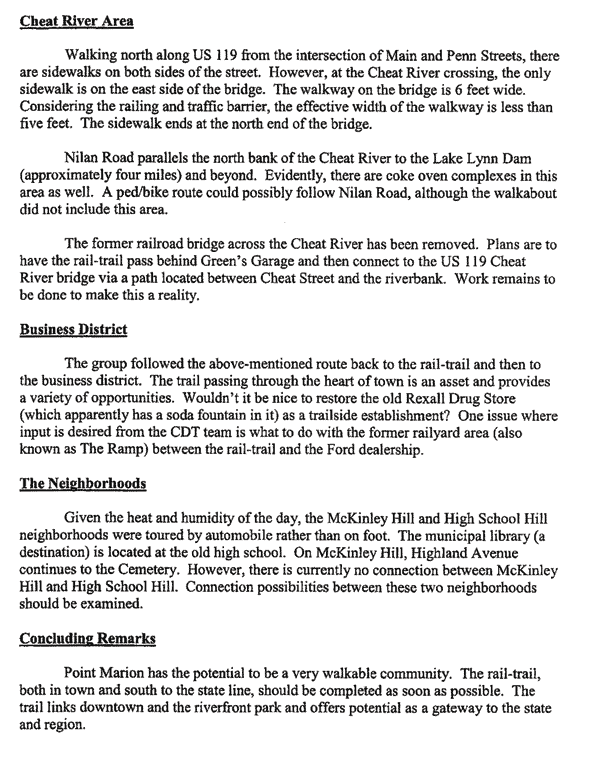
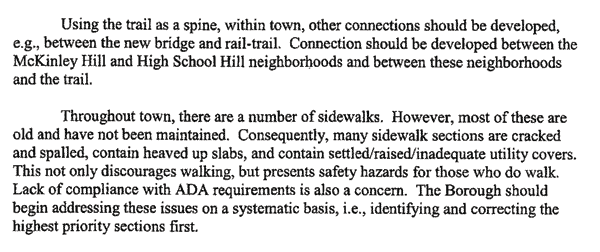
The following are screen captures from the Safety Software Suite, which the Utah SCR utilizes to provide technical assistance and RSA activities. Figure E.1 is a screen capture from the sign management module. This module allows agencies to track the location, date of installation, and condition of their signs. Figures E.2 and E.3 are screen captures from the RSA module. Figure E.2 shows a tool that is used during roundtable discussions when conducting RSAs. The team can utilize this module to easily track the location and details of each issue identified during the RSA process as well as the relative severity and recommended actions. Figure E.3 shows a sample report that is automatically produced based on the inputs from the roundtable discussion. The report includes a summary of the issue identified, the location, recommended actions, and even a picture to illustrate the issue.
Figure E.1 Screen Capture from Sign Management Module
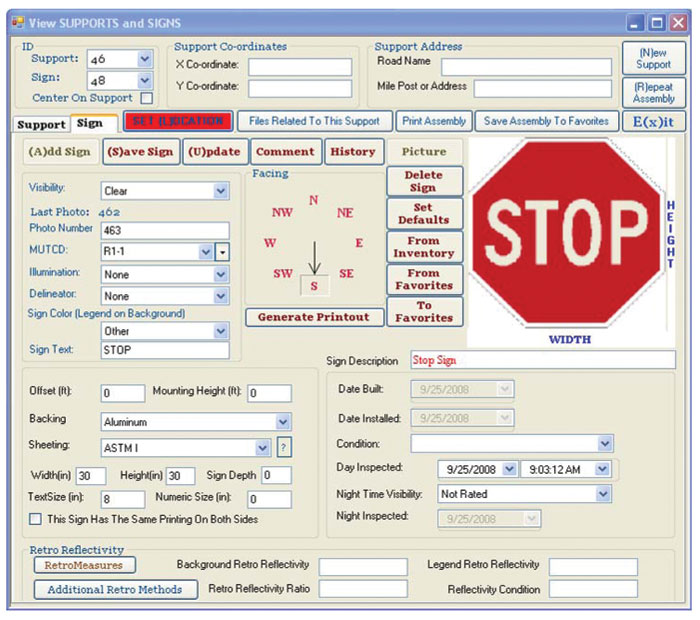
Figure E.2 Screen Capture from RSA Module – Data Entry Tool
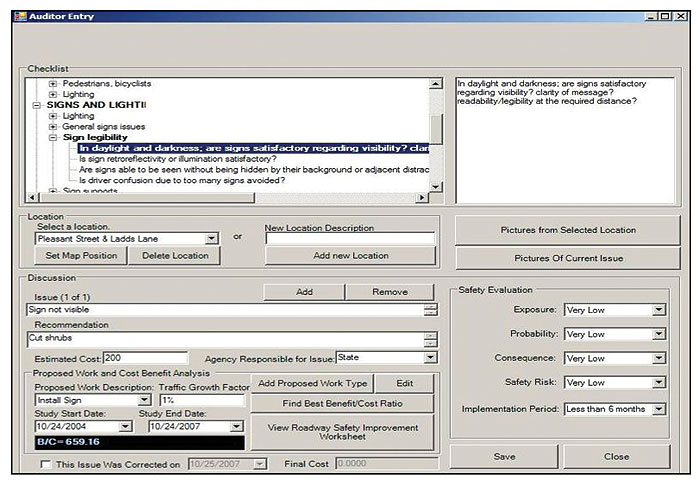
Figure E.3 Screen Capture from RSA Module – Reporting Tool
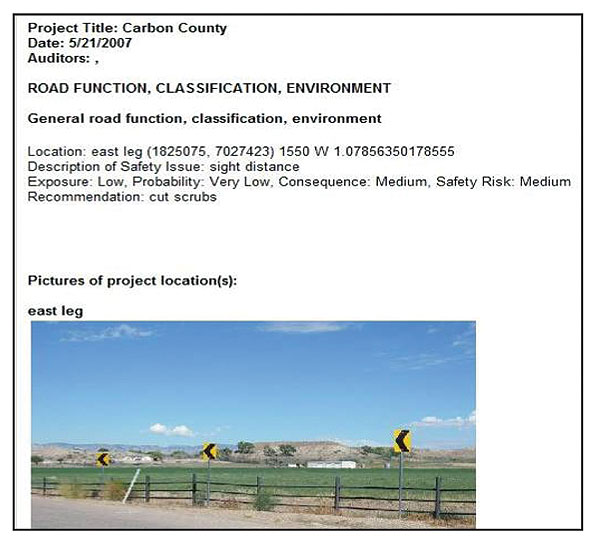
Safety Circuit Rider Quarterly Report
Fiscal Year 2008 - Quarter Number 2
October through December 2007Safety Circuit Rider
Scheduled and participated in several progress meetings for research projects including safety corridors in Iowa, installation and evaluation of rumble stripes on local roads, and crash analysis on very low volume rural roads. Participated in the 2007 MINK conference on October 23rd and 24th in St. Joseph, MO, LTAP Advisory Committee meeting, Midwest Transportation Consortium Symposium in Ames, Traffic Safety Alliance meeting in West Des Moines, STRCC meeting in Ames, and Traffic Safety Forum in West Des Moines. Scheduled and participated in three Local Road Safety workshops with 100 participants in Ames, Car roll, and Iowa City. Participated in two road safety audits in eastern Iowa. Presented work shops on registered flagging with 21 participants and DOT flagging with 8 participants. Scheduled and participated in a teleconference and video conference for the Smart Work Zone Deployment Initiative Board of Directors. Participated and made presentation in a web conference on safety circuit riders.
Community Traffic Safety Team (CTST) Meeting in Heathrow, FL: In January 2008, Larry Hagen (FL SCR) instructed a RSA workshop for CTSTs in Heathrow, FL. The CTSTs are important partners of the SCR program, acting as local road safety advocates. The purpose of the workshop was to provide CTST members with a basic understanding of RSAs and better prepare them to identify safety issues and countermeasures in their communities. The workshop was offered free of charge and of the participants that attended the workshop, most had very different backgrounds and reasons for attending. Follow-up interviews were conducted with several participants to determine their reason for attending and satisfaction with the workshop.
Participant #1: Dekova Batey is the Pedestrian and Bicycle Coordinator for the City of Gainesville, FL and also serves on a community advisory board. The CTST to which he belongs would like to perform RSAs in the future, but does not yet have any specific projects in line. He attended the RSA workshop for informational purposes. While he had attended prior RSA training, he indicated that this workshop was very useful and provided a different perspective on RSAs. He appreciated the training opportunity and felt that it was useful knowledge to bring back to the CTST. He felt the knowledge would also be useful when dealing with public concerns and reviewing future pedestrian and bike projects. The participant noted that the instructor- led training was a benefit compared to distance learning because it allowed for in-field experience and a very interactive atmosphere with input from several individuals with different backgrounds.
Participant #2: Michael Kautz had recently been promoted to Highway Safety Program Manager for District 1 of the Florida DOT, but was unfamiliar with RSAs. He attended the workshop to learn about the RSA process. He indicated that the course provided an appropriate amount of information and he now has a good understanding of the RSA process. Within one month of the training, they had already conducted an RSA, including multijurisdictional inputs. He noted that the instructor-led training was beneficial because it provided an opportunity for actual field experience and dealt with local issues.
Participant #3: Noble Olasimbo is the Transportation Planning Section Manager for the Lake County Public Works Department and is responsible for their Traffic Safety Team. He attended the workshop for continuing education purposes to be better prepared in his supervisory role. He noted that his county had conducted a few RSAs, but they may ask the SCR to attend a future RSA to identify opportunities for improvements in their process. He indicated that the RSA workshop was very good overall and provided information from many different perspectives. He had a relatively good background in safety before the workshop, but the workshop helped to enhance his current knowledge. He added that he has a much better understanding of the RSA process and purpose after attending the workshop. He mentioned that it was very helpful to go into the field as part of the workshop, but did not feel that online training would hinder the field exercise because a lot could be done with technology. He indicated that it is more important to have a diverse group of participants because the input from various perspectives helps to enhance the learning experience. He felt that the target audience is also an important factor for determining the structure of the workshop. He indicated that younger participants may be more amenable to online training while older professionals may prefer the hands-on and in-class approach. He noted that travel costs could play a factor in the type of training, particularly for local governments that do not have a large travel budget. Regarding the length of the workshop, he indicated that it depends on the responsibilities of the participants. For senior management, he felt that the workshop was sufficient; however, for those who are involved with RSAs on a regular basis, it may be more appropriate as a 2-day course. While the course was offered free of charge, the participants had to donate their time and the participant mentioned that it would be nice if the training counted toward professional development.
Participant #4: Linda Spivey works for a Florida Senator and attends CTST meetings on behalf of the Senator. The participant had attended the workshop to learn more about RSAs and would like to take a more active role in safety as a private citizen after her job with the Senator.
Technical Assistance for City of Fairmont Public Works, WV: The public works department in Fairmont, WV has requested technical assistance from the SCR on two different occasions. In November 2006, there was a request for the SCR to review parking along Monroe Street in Fairmont, WV. The request was made to determine if parking could be increased by converting the parallel parking to angle parking. Based on a review of the literature, it was determined that angle parking is more hazardous than parallel parking. Based on a review of the site conditions, it was determined that the street was too narrow to provide angle parking and no changes were made. While there were no changes as a result of the technical assistance, the public works representative indicated that the SCR was very helpful and provided the necessary guidance to determine the feasibility of increasing parking. Had the parking been converted without consulting the SCR, safety issues may have arisen as a result of the narrow roadway width and hazards associated with angle parking. In May 2007, the public works department once again contacted the SCR for technical assistance. The concern was that vehicle speeds are increasing in the vicinity of the college campus (Fairmont State University). Residents contacted the public works department and requested speed bumps for their neighborhood. The city has a policy to avoid the use of speed bumps, but was amenable to the installation of speed humps if necessary. The SCR provided drawings of typical speed humps, including dimensions, and discussed potential issues with drainage and snow plows. There was not enough local support to install the speed humps, but the city is currently monitoring the situation and is prepared to install speed humps if necessary. The representative indicated that the SCR was extremely helpful in both situations and the technical assistance was greatly appreciated.
Walkability Audit of Concord University and Town of Athens, WV: At the request of a faculty member at Concord University, the West Virginia SCR led a walkability audit on October 18, 2006 to assess the walkability of portions of the Town of Athens and the Concord University Campus. The university was interested in providing a more pedestrian-friendly campus and the community was interested in enhancing pedestrian safety, particularly for elementary and high school students. The SCR identified several opportunities for improvements to the current facilities to promote walking and perhaps even enhance safety for pedestrians. The SCR also provided a formal written report documenting the findings and recommendations.
The technical assistance was deemed a success, according to the faculty member. They noted that the walkability study helped to spark interest in pedestrian issues throughout the university and community. Also, the community applied for a grant through Safe Routes to School to implement several of the recommendations from the walkability study. They included several portions of the SCR’s report in their application and were awarded the grant. While the community is waiting to receive the grant funds before implementing many of the recommendations, there have been a few changes made. For example, there was one location where cars were allowed to park on part of the sidewalk, causing an obstruction for pedestrians and forcing them into the street to avoid the parked cars. The SCR suggested repainting the stalls as angle parking. This recommendation was implemented and now the parked vehicles do not create an obstruction for pedestrians.
Technical Assistance for a Local Homeowners Association, West Virginia: A faculty member at West Virginia University requested the services of the SCR on behalf of their local homeowners association. The homeowners association was concerned with pedestrian safety. The SCR conducted a walk-through of the community to determine if additional signing and pavement markings were necessary. The SCR recommended the installation of a standard pedestrian warning sign near the entrance to the community. The SCR also recommended the installation of a turn warning sign with an advisory speed plate in both directions in advance of a sharp curve. The Board of the homeowners association approved the purchase of the signs, but the signs have not yet been purchased.
Other recommendations included a speed hump to maintain low speeds in the area and drainage improvements to prevent further roadside erosion. While the recommendations have not yet been implemented, the requesting faculty member indicated that the SCR was very helpful and the technical assistance was greatly appreciated. Specifically, they noted that the SCR provided detailed design and installation criteria for the signing, which would be useful when the signs are finally ordered and installed.
Walkability Workshop and Audit in Point Marion, Pennsylvania: A participant of the walkability workshop and audit indicated that Point Marion became involved with the SCR as part of a Community Design Team (CDT) application to West Virginia University. As part of the application process, Point Marion conducted a First Impressions workshop as well as a Walkability workshop and study. The SCR conducted the Walkability workshop and led a walkabout in the town of Point Marion. The SCR pointed out several opportunities to improve the walkability and connectivity within the town and between neighborhoods. Unfortunately, the recommendations have not yet been implemented in full due to funding limitations and competing needs in the town. However, as the town’s water distribution system is updated, the surrounding roadways and sidewalks are also improved, which is helping to enhance walkability. The participant indicated that the SCR was very helpful and aside from the recommendations provided by the SCR, the experience has helped to “heighten awareness” of pedestrian and bicycle issues within the town.
Continuing Education for Virginia Section of the Institute of Transportation Engineers (VASITE): A member of the VASITE Board of Directors indicated that she had taken a course on pedestrian and bicycle safety, which was instructed by the West Virginia SCR. After the course, the member followed-up with the SCR on various occasions for technical assistance. She indicated that the SCR was always very helpful and responsive. For example, they had a question regarding the design of the width, buffer, and driveway considerations for a sidewalk along a suburban road. The SCR provided his thoughts on the topic as well as links to several FHWA and AASHTO resources that contained additional information. The member was also responsible for identifying and scheduling continuing education for VASITE. She indicated that the SCR has instructed a pedestrian and bicycle safety course for VASITE and they have been very satisfied with the training.
